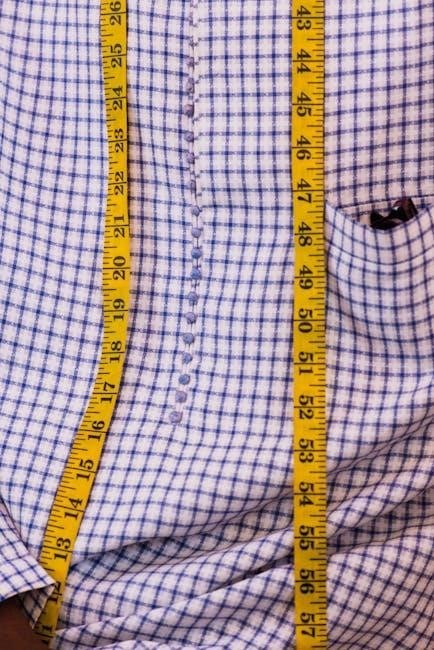An essential tool for ensuring the perfect fit, this guide provides detailed insights into measuring t-shirts, covering key dimensions and sizing variations to help you shop with confidence.

Importance of Accurate Measurements
Accurate measurements are crucial for ensuring the perfect fit of a t-shirt. Whether you’re shopping online or in-store, proper sizing prevents issues like tightness, looseness, or an unflattering silhouette. Ill-fitting clothes can lead to discomfort and a lack of confidence, making precise measurements essential. By taking the time to measure correctly, you avoid the hassle of returns or alterations. Additionally, accurate measurements help maintain the intended style and comfort of the garment, as designers craft clothes with specific fits in mind. Understanding your measurements also aids in comparing sizes across different brands, which often vary slightly. Ultimately, precise measurements empower you to make informed purchasing decisions, ensuring your t-shirt looks and feels its best.
Overview of T-Shirt Sizing Charts
T-shirt sizing charts provide a standardized reference for determining the best fit based on body measurements. These charts typically include dimensions such as chest circumference, waist, hip, shoulder width, shirt length, and sleeve length. Sizes range from Small to XXXL, catering to various body types and preferences. Men’s, women’s, and unisex charts differ, with women’s focusing on bust and waist for a more fitted look, while men’s emphasize chest and shoulders. International variations exist, with UK and US sizes differing slightly. Some charts also account for additional ease, ensuring comfort and mobility. By comparing personal measurements to these charts, shoppers can select the most appropriate size, enhancing their overall satisfaction with the garment’s fit and appearance.

Key T-Shirt Measurements

Chest circumference, waist, hip, shoulder width, shirt length, and sleeve length are key measurements for determining t-shirt size, ensuring a comfortable and accurate fit.

Chest Circumference Measurement
The chest circumference is measured around the fullest part of the chest, just below the armpits, ensuring the tape is flat and parallel to the floor for accurate sizing.

Waist Measurement
The waist measurement is taken around the narrowest part of the natural waistline, typically where trousers or skirts button up. For accurate sizing, the tape measure should be kept level and not too tight or loose. This measurement is crucial for determining the fit of the t-shirt, especially for styles designed to be fitted or tapered. For men, the waist measurement helps ensure the shirt isn’t too snug or boxy, while for women, it often complements bust measurements for a flattering silhouette. Unisex t-shirts may have a more relaxed fit around the waist. Always compare your measurement to the brand’s size chart, as variations can occur between labels. Ensuring the tape is parallel to the floor and the shirt lies flat during measurement guarantees precision. This step is vital for achieving a comfortable and well-fitting garment.
Hip Measurement
Hip measurement is typically taken 7-9 inches (18-23 cm) below the waistline, around the fullest part of the hips. This measurement is essential for determining the fit of t-shirts, especially for styles designed to be fitted or tapered. For women, hip measurements are often used in conjunction with bust and waist measurements to ensure a balanced fit. Men’s t-shirts may not always require hip measurements, but they can be relevant for certain styles, such as slim-fit or athletic cuts. Unisex t-shirts often have a more relaxed fit around the hips. Always compare your measurement to the brand’s size chart, as variations can occur between labels. Ensuring the tape is parallel to the floor and the shirt lies flat during measurement guarantees precision. This step is vital for achieving a comfortable and well-fitting garment.
Shoulder Width
Shoulder width is a critical measurement for ensuring a proper fit, especially in men’s and unisex t-shirts. It is measured across the upper back, from the tip of one shoulder to the tip of the other, following the natural curve of the body. This measurement helps determine how the t-shirt will sit on the body, with broader shoulders requiring a larger size for comfort and a more tailored appearance. For accurate results, the t-shirt should be laid flat on a surface, and the measurement should be taken from seam to seam directly across the shoulders. Comparing this measurement to the size chart ensures the sleeves and neckline align correctly. Shoulder width is particularly important for athletic-fit or slim-fit styles, where a precise fit is essential for both comfort and aesthetics. Always use a flexible tape measure for the most accurate results.
Shirt Length
Shirt length is a fundamental measurement for ensuring comfort and style. It is measured from the highest point of the shoulder, just below the neckline, to the bottom hem of the t-shirt. For men’s and unisex styles, the average length for a size medium is approximately 27-28 inches (68-70 cm), though this can vary by brand and style. Women’s t-shirts may be slightly shorter, often ranging from 24-26 inches (61-66 cm). When measuring a lying-flat t-shirt, place it on a smooth surface and measure from the center back of the neckline to the bottom edge. This ensures accuracy and consistency. Shirt length is crucial for achieving the desired fit, whether it’s a relaxed, fitted, or cropped style. Always consider personal preference and the intended use of the t-shirt when selecting the appropriate length. Proper measurement ensures the t-shirt sits comfortably and flatters the body shape. Accurate sizing is key to avoiding a shirt that is too short or overly long. By measuring shirt length carefully, you can eliminate guesswork and find the perfect fit for your needs. This measurement, combined with chest and shoulder dimensions, guarantees a tailored look and optimal comfort. Always use a flexible tape measure for the most precise results, and compare your findings to a reliable size chart. This ensures the t-shirt aligns with your body proportions and personal style preferences. Shirt length is a vital aspect of the t-shirt measurement guide, providing clarity and confidence in your purchasing decisions.
Sleeve Length
Sleeve length is a critical measurement for ensuring comfort and style. It is measured from the center back of the neckline, over the shoulder, and down to the wrist. For men’s and unisex t-shirts, sleeve length typically ranges from 7-9 inches (18-23 cm) for short sleeves, while long sleeves may extend to 24-26 inches (61-66 cm). Women’s sleeves often vary, with short sleeves averaging 5-7 inches (13-18 cm) and long sleeves reaching 22-24 inches (56-61 cm). When measuring a lying-flat t-shirt, align the sleeve evenly and measure from the shoulder seam to the cuff edge. Accurate sleeve length ensures the t-shirt fits comfortably and suits the intended use. This measurement, combined with chest and shirt length, helps achieve a balanced fit. Always compare your measurements to a size chart for the best results, ensuring the sleeves are neither too short nor too long for your preference. Proper sleeve length enhances both comfort and aesthetics, making it a vital part of the t-shirt measurement guide.

How to Measure a T-Shirt
Lay the t-shirt flat, smooth out wrinkles, and use a flexible tape measure to record accurate chest, waist, sleeve, and shirt length measurements.
Measuring a Lying Flat T-Shirt
To accurately measure a t-shirt, lay it flat on a smooth surface, ensuring no wrinkles are present. Use a flexible tape measure at least 36 inches long for precise results. Start by measuring the chest circumference across the widest point, typically 1-2 inches below the armpits. Next, measure the shoulder width from one shoulder seam to the other. For shirt length, measure from the base of the neckline at the back to the bottom hem. Sleeve length is measured from the shoulder seam to the cuff edge. Record all measurements carefully, ensuring consistency. Comparing these measurements to a size chart will help determine the best fit. Always measure twice to confirm accuracy and avoid errors in sizing.
Body Measurements for Size Selection
Accurate body measurements are crucial for selecting the right t-shirt size. Start by measuring your chest circumference, which is the fullest part around your torso, just below the armpits. For men, this is typically the broadest point, while for women, it includes the bust. Next, measure your waistline, where your trousers typically sit, to determine your natural waist size. For women, hip measurements are also important, taken around the widest part of the hips, usually 7-9 inches below the waistline. Additionally, consider your height and weight, especially for children’s sizes, as these can influence fit. Use a flexible tape measure and take measurements while standing straight. Compare these body measurements to a size chart to find your ideal t-shirt size, ensuring comfort and the desired fit. This approach helps eliminate guesswork and ensures a perfect match every time.
International T-Shirt Size Variations
UK, US, and European sizing differ slightly, with variations in chest, waist, and length measurements. Men’s, women’s, and unisex sizes also have distinct fits and standards globally.
UK vs. US Sizing Differences
UK and US t-shirt sizing differs slightly, with UK sizes often running smaller than US sizes. For example, a UK Small may equate to a US Medium. Chest measurements are a key factor, with UK sizes typically measuring 2-3 inches smaller than their US counterparts. Waist and length measurements also vary, reflecting regional fit preferences. Men’s sizes in the UK generally start at XS (32-34″ chest) and go up to XXL (47-49″), while US sizes may offer more extended sizing options. Women’s and unisex sizes also show similar patterns, with UK sizes tending to be more fitted. Understanding these differences is crucial for international shoppers to ensure the best fit. Always refer to specific size charts for accurate measurements, as variations can occur between brands and styles.
Men’s, Women’s, and Unisex Sizing
Men’s, women’s, and unisex t-shirt sizing caters to different body types and preferences. Men’s t-shirts are designed with broader shoulders and a straighter cut, often ranging from Small to 3XL. Women’s t-shirts focus on bust and waist measurements, offering a more fitted silhouette. Unisex t-shirts provide a versatile option, suitable for all genders, but may require sizing adjustments for the best fit. While men’s sizes emphasize chest and shoulder measurements, women’s sizes prioritize bust and waist. Unisex sizes bridge the gap, offering a balanced fit. However, variations exist between brands, so comparing measurements to specific size charts is essential. Understanding these differences helps shoppers choose the most flattering and comfortable option, ensuring a perfect blend of style and comfort across all genders.
